Ever had a meal that’s as easy to carry as your smartphone and as delicious as a five-star gourmet dish? Welcome to the world of pizza al taglio!
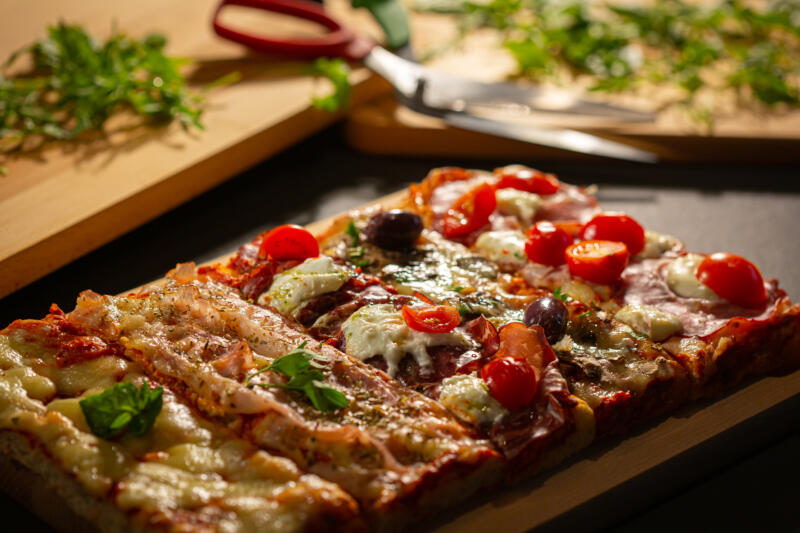
This Italian culinary gem, originally designed as a ‘grab-and-go’ street food, has sneakily climbed the culinary ladder and now rubs shoulders with the gourmet bigwigs.
Each bite of pizza al taglio is like a mini Italian opera playing on your taste buds, with a crispy crust, rich toppings, and heavenly cheese that could make even the toughest food critic swoon.
From a simple street food, pizza al taglio has donned the chef’s hat and become a gourmet sensation, all while staying true to its roots of simplicity and accessibility.
In this article:
What is Pizza al Taglio?
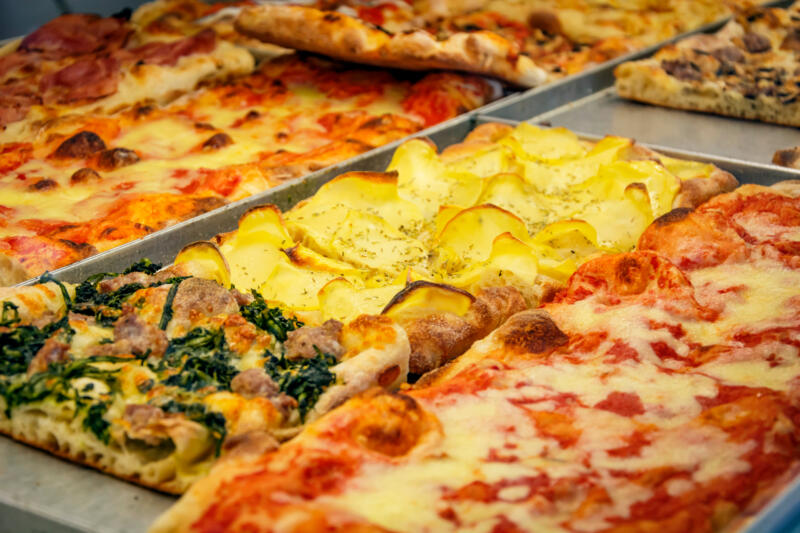
Pizza al taglio (pronounced as pee-tsa ahl tah-lyoh), a term that literally translates to “pizza by the cut,” is a popular style of pizza that originated from Rome, Italy.
This pizza is known for its distinctive rectangular shape and size, which makes it easy to cut and serve in varying portions.
The dough of pizza al taglio is unique, characterized by a high hydration level that results in a crust that is airy and slightly crunchy on the outside, yet soft and chewy on the inside.
This pizza is typically baked in large rectangular trays, and the end result is a thick but light crust that can support a variety of toppings.
Speaking of toppings, pizza al taglio is a canvas for creativity.
Traditional toppings range from the classic Margherita to more adventurous flavor profiles like potato and rosemary or spicy salami.
However, the beauty of pizza al taglio lies in its ability to create multiple flavor zones on one pizza, allowing for a diverse and exciting eating experience.
Origins of Pizza al Taglio
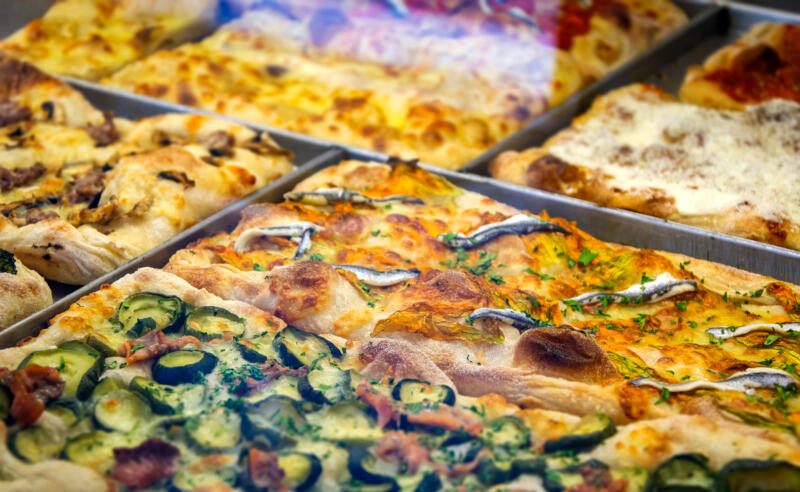
The history of pizza al taglio is as rich and flavorful as the pizza itself. This style of pizza became popular in Rome in the 1950s, initially sold in bakeries due to its rectangular shape which made it easy to cut and sell by the slice.
The name “al taglio” (pronounced as ahl tah-lyoh) itself signifies this method of serving – cut to order and sold by weight.
The concept of creating multiple flavor zones on one pizza is a significant aspect of pizza al taglio. This allows for a variety of toppings on a single pizza, catering to different tastes and preferences.
Whether you’re a fan of the classic tomato and mozzarella or prefer more unique combinations, there’s a slice of pizza al taglio for everyone.
Dough
Before we dive into the specifics of making the dough for pizza al taglio, it’s important to understand the role it plays in the overall pizza experience.
The dough is the foundation of any pizza, and for pizza al taglio, it’s all about achieving that perfect balance of crunch and chew.
Ingredients for Dough
The dough for pizza al taglio requires a few simple ingredients:
- warm water,
- dry yeast,
- salt,
- sugar,
- oil,
- bread flour or “00” flour.
These ingredients, when combined in the right proportions and handled with care, create a dough that is light, airy, and flavorful.
Making the Dough
First, the yeast is activated in a mixture of warm water, sugar, and olive oil.
The ideal temperature for activating dry yeast, which is typically used in pizza dough, is between 105° and 115°F (40° – 46°C).
In case the water is too cold, the yeast won’t activate; and if it’s too hot, there’s a chance of killing the yeast.
It’s important to note that temperatures above 120°F (49°C) may kill the yeast, preventing the dough from rising.
Once the yeast is frothy and active, it’s combined with the bread flour and salt.
The dough is then mixed until it forms a sticky ball. This is where high hydration comes into play – the dough should be wetter than your typical pizza dough.
It’s this high hydration that allows for long fermentation, resulting in a crust that is both strong and tender.
After the initial mixing, the dough is left to rest and undergoes a process called autolyse. During this time, the flour absorbs moisture and gluten starts to form.
After the rest, the dough is kneaded until smooth and elastic.
Letting the Dough Rise
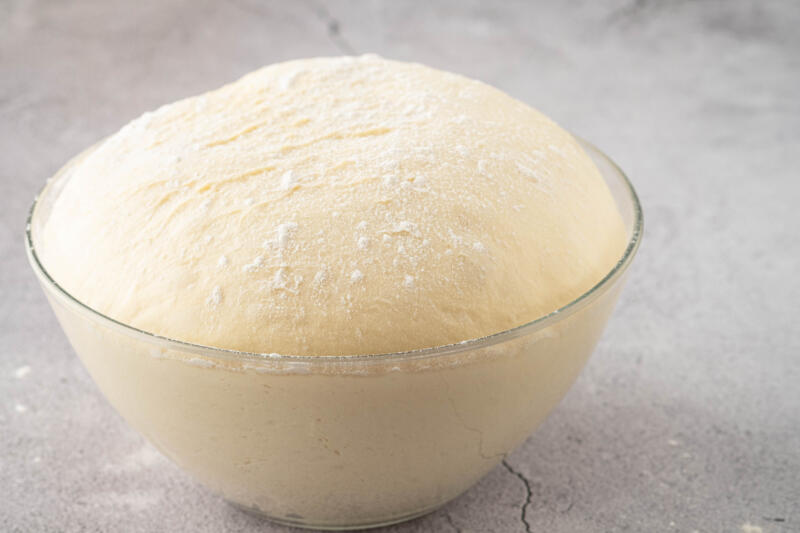
The final step in the dough-making process is proofing. The dough should be placed in a large, oiled container to allow for expansion.
The ideal environment for this process is a warm, draft-free area.
The dough is allowed to rise until its size doubles, which can vary from 1 to 24 hours based on temperature and yeast quantity.
Monitoring the dough during this time is key to prevent it from overflowing its container.
If it looks like the dough might overflow, it can be gently deflated and transferred to a larger container.
This long fermentation period is another key to achieving the distinctive crust of pizza al taglio.
Prepping the Dough
Once the dough has risen, it’s time to prep it for baking.
Start by liberally flouring your work surface to prevent the dough from sticking. Then, gently turn out the dough onto the surface, being careful not to deflate it too much.
Shaping the dough is a delicate process. The goal is to maintain as much of the air in the dough as possible, so be gentle.
Use your fingertips to dimple the dough and shape it into a rectangle. This creates pockets that become airy and light during baking.
Feel free to add extra flour if the dough is sticky.
The key is to handle the dough with care to achieve the perfect pizza al taglio crust.
Toppings
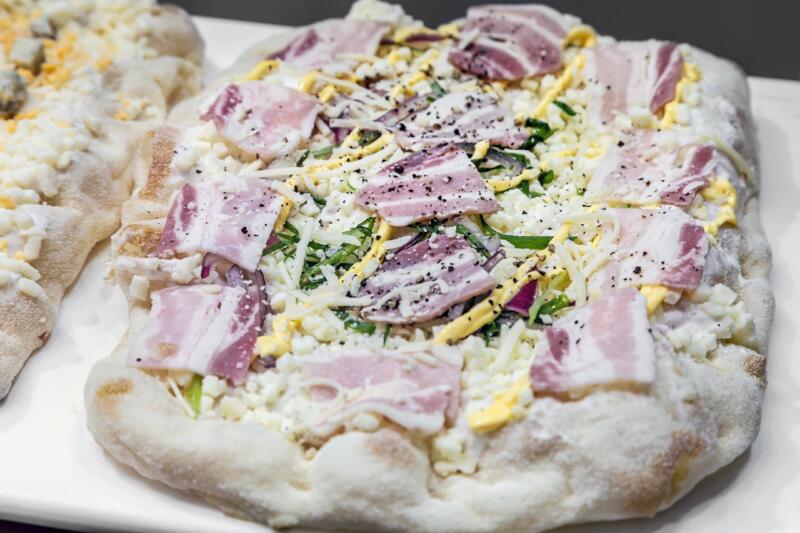
Now that we’ve mastered the dough, it’s time to move on to the fun part – the toppings. What’s wonderful about pizza al taglio is its versatility in toppings, offering limitless possibilities for flavor combinations.
Popular Topping Combinations for Pizza al Taglio
When it comes to topping combinations for pizza al taglio, the possibilities are endless.
- Pizza Bianca: This is a simple pizza topped with olive oil, garlic, and rosemary.
- Pizza Margherita: A timeless pizza featuring tomato sauce and mozzarella cheese on top.
- Pizza with Mixed Roast Vegetables: This pizza features a variety of roasted vegetables as toppings.
- Pizza with Potatoes: A rustic and hearty option, this pizza features thinly sliced potatoes, often seasoned with rosemary, garlic, and olive oil. Sometimes, it might also include bits of pancetta or sausage for an added flavor punch.
- Pizza with Prosciutto: Topped with tomato, mozzarella, and ham.
- Pizza with Sausage: This pizza is topped with tomato, mozzarella, and sausage.
- Pizza Capricciosa: Boasts toppings of tomato, mozzarella, mushrooms, artichokes, sausage or ham, and occasionally egg.
- Four Cheese Pizza (Quattro Formaggi): Crowned with an assortment of four distinct types of cheese.
- Vegetarian Pizza (Con Verdure / Vegetariana): This pizza commonly showcases tomato, mozzarella, peppers, eggplants, and zucchinis as toppings.
- Pizza Amatriciana: Inspired by the classic pasta sauce from Amatrice, this pizza is topped with tomato sauce, guanciale (cured pork cheek), pecorino cheese, and sometimes a hint of chili.
Innovative Topping for Pizza al Taglio
When it comes to topping combinations for pizza al taglio, the possibilities are endless.
Traditional toppings have always been a favorite, but innovative chefs like Gabriele Bonci have taken it to the next level.
He is the owner of the famous Pizzarium in Rome, a place that has become a pilgrimage site for pizza lovers from around the world.
Bonci stands out for his innovative approach to pizza toppings, using both classic Roman ingredients, such as amatriciana, carbonara, chicken and peppers, and more creative and unexpected combinations like zucchini alla scapece, stracciatella and mint, or tuna and onion.
His toppings are not static but change frequently throughout the day, reflecting the availability of fresh, locally sourced ingredients and the seasonality of produce.
This dynamic approach to toppings, coupled with his commitment to high-quality ingredients and his unique, airy and light dough, sets Bonci apart from other pizza chefs.
His creativity and dedication to his craft have earned him a reputation as one of the leading figures in the world of pizza al taglio.
Baking Techniques
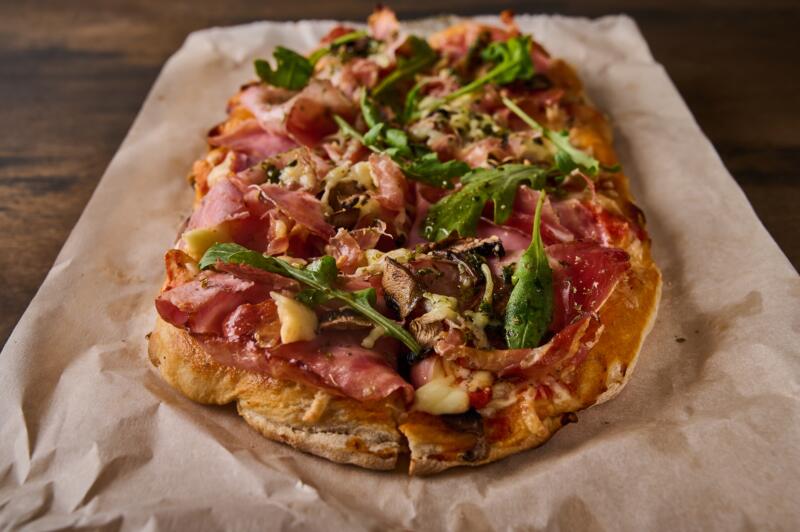
Pizza al taglio is usually baked at high temperatures for a brief duration, yielding a crust that’s crisp on the exterior while remaining soft and airy within.
Using a Rectangular Tray or Baking Sheet
To bake pizza al taglio, you’ll need a rectangular tray or baking sheet. The size of the tray should fit the size of the dough.
A nonstick tray is ideal, but if you don’t have one, a regular tray generously oiled will do the trick to avoid sticking.
Preheat your oven to the temperature specified in your recipe. Once the dough is prepped and topped, place the tray in the oven.
A general guideline is to bake it at a high temperature (around 500°F or 260°C) for about 10-15 minutes.
Keep in mind that the baking temperature and duration may differ based on the recipe you’re following and the particular oven in use.
Continue baking until the crust achieves a golden hue and the cheese is melted and slightly browned.
Be vigilant to avoid burning or undercooking the pizza.
Regional Variations and Popular Types
Pizza al taglio may have its roots in Rome, but its popularity has led to regional variations and creative adaptations.
The traditional Roman-style pizza al taglio is characterized by a thick but airy crust, simple toppings and is typically sold by weight.
However, as this style of pizza has spread, so too has the creativity in its execution.
Gourmet variations of pizza al taglio can be found in upscale pizzerias, featuring high-quality ingredients and unique flavor combinations.
Meanwhile, international adaptations have seen the incorporation of local flavors and ingredients, resulting in a global pizza experience that still pays homage to its Roman origins.
Why Pizza al Taglio?
The appeal of pizza al taglio lies in its versatility and convenience.
Its rectangular shape and cut-to-order serving style make it an easy option for a quick lunch, a casual dinner, or a party snack.
The ability to customize each slice with different toppings adds to its appeal, catering to a variety of tastes and dietary preferences.
Moreover, pizza al taglio lends itself to a social and communal dining experience.
Thanks to its generous size and variety of toppings, it’s an ideal option for sharing with friends and family.
Each slice offers a different flavor profile, making the dining experience exciting and diverse.
Its popularity has even led to its presence in supermarkets and convenience stores, making it a truly accessible food option for everyone.
Closing Thoughts
From its distinctive dough and versatile toppings to its unique serving style, pizza al taglio is a pizza experience like no other.
Whether you’re a fan of the traditional Roman-style or prefer the creative gourmet variations, there’s a pizza al taglio for everyone.
As we continue to explore and appreciate this unique style of pizza, we can look forward to future trends and evolving popularity.
Will we see new topping combinations? Different dough variations? Only time will tell.
In the meantime, we invite you to share your thoughts, questions, and experiences with pizza al taglio. After all, pizza is best enjoyed when shared.